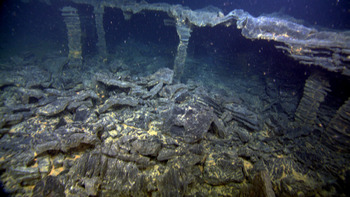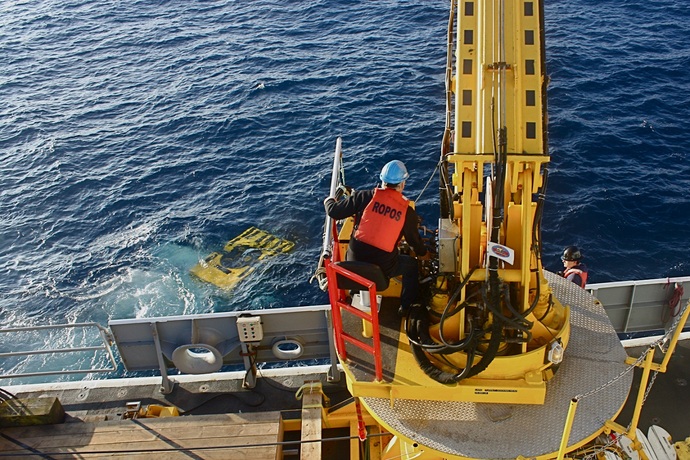
The ROV ROPOS gently flew into a small collapse basin marked by pillars, arches and isolated columns of basalt. These areas form as lava drains out from deep lava pools. The surface of the lava lake or channel very rapidly cools as it interacts with near freezing seawater. As the lava drains out, the roof is not strong enough to maintain its weight, and collapses into a pile of talus.

Pillars of the Ocean
After having a few shifts in the ROV room, which is quite the experience, I can honestly say that watching these guys operate their sub is slightly hilarious. The other night they were sitting in the dark control room, navigating and steering the thing along as if what they are doing is no different than driving a golf cart. Then in a nonchalant yet polite way (these guys are very Canadian and very polite), one of the pilots explained to me that he was part of the core group that both designed and built this multi-million dollar monster. And this sub is cool, really cool. Its main HD camera is a bulbous orb larger than the size of my head, and it even has a couple back up cameras pointing in various directions. It has two extendable, articulated arms with claws for grabbing samples, and the claws have force-feedback functionality. That means that when the operator is using one of the arms to grab a rock, he can actually feel it on his control board when the claw touches the rock. ROPOS also has a slurp gun for grabbing your more watery samples and a number of sampling boxes for holding rocks. The sub has more propellers and jets on it than our ship I believe, oh, and it has its very own custom-made crane for going in and out of the water.
My official part in the ROPOS operations is to be the HD camera operator. That means that during my shift I control the iris of the camera to make sure that the right amount of light enters the camera so that the video streaming back to shore is viewable. However, last night when my shift started (at midnight), the ROPOS crew had just begun pulling the sub back up to the deck for some maintenance work. So instead of working the camera we worked on unloading the rock and water samples that had been collected over the course of the day. These samples were collected in a very expensive and laborious way, sending a deep water ROV thousands of meters down in the ocean to get them, so there’s no way I can truly explain how privileged I felt to be part of the group processing them. After three years of science and oceanography courses and seeing pictures of people doing this sort of work, suddenly I got to be the guy doing it.
Oh also, I sighted an Albatross from the ship’s bridge today. It was great but don’t ask me what kind of Albatross it was.

